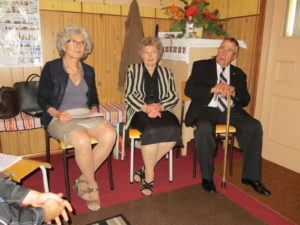Yordan and Blessed Water
Yordan (Jordan), also called Epiphany and Theophany (January 6, Gregorian calendar; January 19, Julian calendar)is the commemoration of the baptism of Christ. In terms of folk practice, on Yordan, people are supposed to go down to the local body of water and cut a hole in the ice, preferably in the shape of a cross. The priest will then bless that water and people will drink some and take some home to use for medicinal purposes. Some people bathe (or at least take a dip) in Yordan water because this is said to bring good health. On the prairies, because of their severe weather and because of sparse population and lack of clergy, a full Yordan celebration is rare. Even in large urban churches, it is far more common to bring water into church for a Yordan blessing than to go out to the river or lake for ice-cutting.
House blessings – are typically done shortly after Yordan. The priest will go to a home and bless it with holy water. This service helps raise money for the church. In some rural areas, priests still do blessings of the homes of all parishioners who ask for this service and, where this occurs, such as in Goodeve, Saskatchewan, people interviewed would often boast of this fact to the Sanctuary team. In most rural areas there is simply not enough manpower, or priest power, for such blessings and people use holy or blessed water to do their own house blessings.
Holy or blessed water is an important part of vernacular faith. Yordan is not the only time that water is blessed and the other typical water-blessing event, especially in rural parishes with few services, is Khram or Praznyk.
Holy water is drunk as part of the church service during which the water is blessed and is said that this ensures good health.
Most people take a bottle or jar of water home and drink it whenever they feel unwell. Some people apply holy water topically to sore joints or to injuries. A respondent from Lloydminster, Alberta said that he bathed in holy water. According to him, holy water was so powerful that adding even one drop would bless the entire bath and bring him physical and spiritual health.
A few respondents mentioned give holy water to colicky babies or to children having nightmares.
One respondent mentioned giving it to accident victims.
After health, the next most common use of holy water was to prevent storm damage. Nellie Kotylak of Montmartre recounted how she prevented a tornado from destroying family property. When she saw a tornado approaching, she took a jar of holy water and ran around the house three times. The tornado damaged the neighbor’s property, came right up to the fence of the Kotylak farm, then turned away. Respondents told of using holy water not only for tornadoes, but also for hail and a peculiar Saskatchewan phenomenon called the plow wind, a very narrow and very destructive line of wind.
Holy water was used to bless seeds before planting and to bless farm animals. Some people mentioned using it to bless gifts, especially those given to small children.
Holy water was used for house blessing where the people did their own blessing for lack of a priest to perform the ritual. Several people mentioned using holy water to bless new cars.
Disposing of holy water – because holy water is a special substance, it must be disposed of in a special way. Typically, holy water is kept for one year from the day on which it was blessed and many people stressed that it stayed pure the entire time: it did not go cloudy or begin to smell bad if it sat for a long time. Should any water remain at the end of the year, it could not be simply poured down the drain. People put it on house plants or outdoor plants and plants that produced food, such as fruit trees, were an especially desirable way of disposing of holy water, since it was still consumed, though in another fashion. Essentially, holy water needed to be treated with deference and respect.

Candlemas, also called Stritenn’e, is, in religious terms, the presentation of Christ in the Temple. In folk terms, this is the day that winter meets summer and candles are blessed in church. Stritenn’e is like Ground Hog Day and falls on the same date for those who follow the Julian calendar. For those using the Gregorian calendar, it is 13 days later. Like Ground Hog Day, this is a time for predicting whether there will be an early spring or a long winter.
Because it comes in February when weather is severe and snow can be piled very high, Stritenn’e is seldom marked in rural churches. The exception is those churches where one of the parishioners is a beekeeper, as in Myrnam, Alberta and Speers, Saskatchewan. Beekeepers usually supply beeswax candles to the church as well as producing honey for commercial purposes. In such churches, a candle blessing is much more likely to occur.
Candles blessed on Candlemas or Stritenn’e are believed to be powerful and to have the ability to avert storms. They are kept in the home from one Candlemas to the next and lit whenever there is thunder. Putting a blessed candle in the window is said to keep inclement and destructive weather away from the home.
The celebration of other spring and summer holy days depends very much on the church, the availability of clergy, and the interests of the parishioners.


